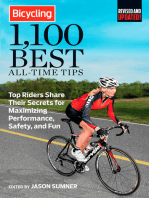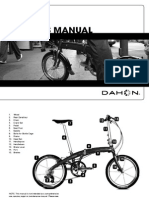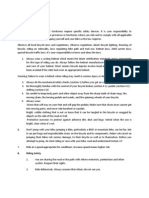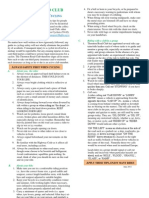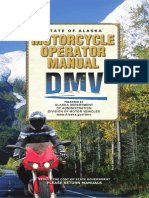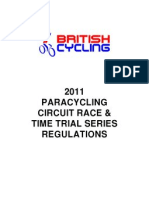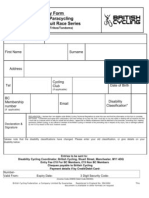Members Guide Issue 1
Members Guide Issue 1
Uploaded by
api-90772375Copyright:
Available Formats
Members Guide Issue 1
Members Guide Issue 1
Uploaded by
api-90772375Original Title
Copyright
Available Formats
Share this document
Did you find this document useful?
Is this content inappropriate?
Copyright:
Available Formats
Members Guide Issue 1
Members Guide Issue 1
Uploaded by
api-90772375Copyright:
Available Formats
Hand Cycling Association UK
Guidance for group road cycling
Scope
This document provides the Associations guidance for members when taking part in any Hand Cycling Association UK (HCAUK) approved road ride on UK public roads. It also provides a description of good practice for any road handcycling.
Introduction
This guide is intended for all HCAUK members who intend to ride on the public roads within a HCAUK group. It should be noted that handcycling on the public roads has an increased level of risk than say, handcycling on a purpose made track. Group road handcycling helps to reduce the risk because a group is more visible to other road users than a solo handcyclists. The experience level of HCAUK members can range from novice to experienced riders. For novice rides the distance is likely to be between 10 to 20 miles over flat or easy terrain and take a couple of hours to complete. At experienced level the distances can be between 50 to 100 miles and are likely to include significant climbs and descents, taking many hours. While handcycling you are likely to suffer muscle fatigue both during and also on the completion of any ride, the amount of fatigue reflects your fitness and familiarity with handcycling. It is better to work your fitness level up slowly, together with your experience, by cycling increasingly longer distances, over varying terrains than attempting a challenging ride before you are ready. HCAUK group handcycling is aimed at the group completing the route together and not racing other group members. Racing on the public highway without all the required permissions and control measures being in place is illegal.
Preparation
Your handcycle
Before riding on the public road, you should be able to sit comfortably for an extended period on your handcycle. Your knees should be slightly bent and not hyper-extended to better absorb bumps in the road and this will also make steering easier. You should be able to use all the handcycle controls, be able to manoeuvre safely and to stop the cycle quickly when required. A cycle helmet, eye protection and high visibility clothing are recommended. These items are not mandatory but non-compliance could
30/12/2011, issue 1
HCAUK, Guidance for group road cycling result in a reduction in any compensation awarded by a court of law in the event of you being involved in an accident. A roadworthy handcycle should have two independent brakes, a bell or horn, a fully functioning and unrestricted drive and steering system. It is also recommended by HCAUK that for road riding, at least a front mudguard is fitted. Rear mudguards make cycling more comfortable for you and any following cyclists when cycling in the wet. It is also recommended that you have some means of ensuring your feet cannot be dislodged from the footrests should you encounter a pothole, or speed bump. It is the riders own responsibility to ensure that their handcycle is suitable for the intended ride. If you are unfamiliar with the requirements of your machine for a particular route, then ask either the organiser, ride leader or an experienced road rider who are always happy to give advice. Generally, handcyclists are unexpected by other road users. The lower profile and the smaller frontal size make it more difficult for other road users to see you at distance. The Longseat and Kneeler style handcycles have a larger frontal area than that of the very low reclined handcycle, currently popular for racing. Because your sight line is higher, when using a Longseat or Kneeler style handcycle, you can see hazards on the road such as potholes at a greater distance than you can on a low reclined style handcycle. This gives you a better chance of avoiding such hazards. The risk of a mechanical failure can be reduced by good and timely maintenance. Tyres and cables are most prone to failure so you should examine them at the end of every ride and repair or replace as necessary. Always ensure your tyres are at the recommended pressure (marked on the sidewall) as this will help to prevent punctures. If you are not competent at cycle maintenance then you should seek help from the handcycle supplier, a local cycle repair shop or any willing experienced cyclist. Low inflated rear tyres can cause your bike to flip over while corning at speed. The side force caused by cornering at speed can distort the tyre wall to the point where it can roll under the wheel rim. The result of this is that the bike is now not pointing in the direction of travel and so will, if you are travelling fast enough, flip over. The factors that contribute to this effect are the speed of travel, the side force generated by the sharpness of the bend and the degree of under pressure of the tyre.
What you need to carry
Before setting out on a ride you should ensure that you have adequate hydration, typically a litre per hour is recommended for energetic cycling in warm conditions. The ride leader or other more experienced riders can advise on the likely duration of the ride and therefore the amount of liquid that you will need to carry. Page 2 30/12/2011, issue 1
HCAUK, Guidance for group road cycling
Carry enough food for the ride and also carry extra food. It is especially useful to carry high energy sugar based foods for the extra. Energy bars and gels are convenient, easily stored and can be eaten and digested quickly. For longer rides you will need to work out for yourself what type of food suits you best and a variety can be useful rather than complete reliance on energy bars. You might find you get tired of them and therefore do not eat enough. Consider the weather conditions that are likely to be encountered during the ride and dress appropriately. It is also good practice to carry a light weight waterproof jacket to cater for any unexpected changes in the weather. It is now common to carry a mobile phone when cycling which can be useful in an emergency. You may be requested to give the ride leader your mobile number which could help to locate you if you become separated from the group. It is good practice to be as self sufficient as possible. Carry a puncture repair kit, pump and spare inner tube as a minimum. In the event of suffering a puncture or other mechanical problem alert the group quickly by shouting puncture or mechanical. The group should stop and decide how to proceed. On longer rides the chances of a mechanical failure increases and it is advisable to consider carrying additional spares such as a tyre, chain links, and brake/gear cable inners together with any tools needed to fit these items. It should be noted that this is not intended to be a prescriptive list as your bike may require other spares.
Before setting off
It is good practice to have an idea of the route before setting off so you do not have to rely on others if you become separated from the group. If the ride is designated as self led, often used when training, then it is your responsibility to navigate the route. Ensure you have a clear understanding of the route and ask if you do not. On some rides a map or a route card may be required, or temporary signs may have been placed to indicate the route. The ride organiser should be able to advise you in all cases.
Good practice while cycling
Personal responsibility
While cycling within a group you are responsible for your own safety. You should always consider what effect any actions you take will have on other road users, especially your fellow riders. Look out for hazards and do not rely on the riders in front. You should always follow the instructions of the Ride Leader or their assistants and adhere to the Highway Code. Do not partake in horse play while cycling. Page 3 30/12/2011, issue 1
HCAUK, Guidance for group road cycling
There is one case where adhering to the Highway Code may not be practical. This is where a road sign requires cyclists to dismount. If you dont or cant dismount, but you pass the sign, you are breaking the Highway Code and you could be breaking UK law. Dont assume that because you are disabled, that you can ignore the Highway Code, you do so at your own risk. It is recommended that you take steps to improve your visibility, such as having a pole mounted flag and wearing high visibility clothing. Using front and rear mounted flashing LED lights also improves your visibility. Flashing lights are now allowed on cycles on UK roads. (Highway Code rule 60) Other road users The Highway Code expects all road users to be aware of and considerate to other road users so it can courteous it you are holding up traffic to pull into the side of the road, when safe, to let them pass. But you are not necessarily obliged to do so. The Highway Code says cyclists should never ride more than two abreast, and ride in single file on narrow or busy roads and when riding round bends (Rule 66). This is especially important for handcycles which are wider than two wheelers. If in a larger group, it is considerate to leave gaps for other road users to use while they are overtake. It is generally advisable not to cycle in the gutter as this is where road debris accumulates and increases the likelihood of punctures. Doing so also encourages a small minority of car drivers to try to pass when it is not safe. The reaction of other road users to handcycles can sometimes be erratic, some over compensate by slowing and pulling in to the side of the road whereas others might pass dangerously close. There have also been reports of foul language to the effect that you should not be using the road. Don't let this put you off. Whatever type of handcycle you ride you have the right to ride on the road. Many of our members have ridden thousands of miles safely. The small frontal area of a handcycle can be a particular hazard when passing parked cars. Occupants have a tendency not to see cyclists of any type and are likely to open doors unexpectedly in your path. If it is safe, it is advisable to allow as much room as possible between you and any parked vehicle, otherwise pass slowly in order that you can stop if a door is opened in front of you. Also for the same reason, be aware that pedestrians can step out in front of you from between parked vehicles. If cycling on a designated cycle way, you must give way to pedestrians. Warn pedestrians of your approach in good time so as not to startle them. If you collide with a pedestrian, you could be liable to pay compensation, or even found guilty of an offence in a court of law.
Page 4 30/12/2011, issue 1
HCAUK, Guidance for group road cycling Handcyclists, should take care to provide other road users with clear signals even though they are using their upper body limbs to crank and steer. But the first priority is to maintain safe control of your handcycle. If your machine is only fitted with one crank-operated brake lever, this can be challenging if the direction you need to turn is the same side as the brake level is fitted. Examples are, when you need to crank with both arms when climbing or while braking as you descending a hill. The provision of brake levers on each crank handle allows braking with one hand while signalling with the other. You must provide the clear signal, even if that requires you to slow or stop. It is better to stop, give a clear signal and only proceed when safe. Horses Horses can be especially startled and frightened by a handcycle and so extra care is required when passing. If you approach a horse from behind, attract the riders attention by shouting cyclist behind. Always ask the rider if it is OK to pass and take heed of their instructions. If given the all clear to pass and the horse remains calm, move over to give as much room for the horse as is practical. If the horse becomes agitated, stop immediately and wait until the rider has the horse under control and indicates that you should proceed. If you have been asked to wait by the horse rider, wait until the horse has passed you before moving off. See the Highway Code rule 215. Braking Performance The weight of the handcycle and rider combination is towards the higher end of the design performance for cycle components. On long and steep hill descents it is possible that the braking system on your bike might lose performance. With a rim brake system this can lead to the rim becoming excessively hot which then may lead to a catastrophic tyre failure. Disc brake performance can significantly fade also due to excessive heating. With a handcycle fitted with both systems, the best strategy to reduce the likelihood of these problems occurring is to alternate your braking between the baking systems. If your handcycle is only fitted with one type of brake system, then stopping occasionally on the descent, to allow the brakes to cool, is a good strategy. Cattle grids Cattle grids present a hazard to handcycles for two reasons; increased risk of puncture and an increased risk of skidding. The first is primarily affected by the combined weight of the handcycle and rider combination, the profile and spacing of the grid rails and the diameter of your wheels. On a sharp profile cattle grid rail, the tyre wall can be damaged such as to puncture the inner tube on both sides. This is known as a snake bite puncture. The second is that the handcycle becomes airborne for short periods as it bumps across the grid giving an effect similar to riding on ice. Page 5 30/12/2011, issue 1
HCAUK, Guidance for group road cycling Both these effects are determined by speed when crossing the grid, the slower you cross the grid the less is the chance of experiencing these effects. Responsibility to others in the group When you are riding in a group you should warn other members of hazards - such as cars that are approaching from the front or from the rear, potholes, junctions etc. The leading rider has the best view of any hazards ahead and should warn cyclists behind in good time to reduce the possibility of collisions within the group. In a large group you should pass any such messages along the line of the group. Agree the calls to be used. It is normal to say when you are slowing or stopping and when there is a hazard on the left or a runner on the right. Get used to talking about the road conditions. Another particular hazard for handcycles is the possibility of receiving blow to your front wheel. If you let your front wheel enter the area between the rear wheels of the handcycle in front of you, who might then move unexpectedly say to avoid a pothole, a blow can result, and in the worst case your handcycle could be tipped over. A race bar is mandatory for racing and it is recommended that one is also fitted for group riding on the road. When cycling within a group try to avoid sudden and unexpected manoeuvres. If you do need to manoeuvre, slow down or stop unexpectedly, shout a warning in good time to the cyclists around you. When climbing a hill, stopping unexpectedly can be very disruptive to cyclists behind you, who may be pacing themselves to reach the hill summit. When overtaking other members of the group call out that you are passing on the right, ensure that you have completely passed before moving back into the single file, dont assume you have passed without looking. Members of the group may have differing cycling styles, for example when approaching a hill climb some cyclists like to select a low ratio gear early in order to climb at a constant rate, while others adopt the tactic of approach the hill as fast as possible to maximise their momentum, changing to lower ratio gears as late as possible. Cornering styles can also vary, with some handcyclists, who have restricted ability to lean their upper body into the corners, and others that can. These differing styles can result in group members cycling at differing speeds for short periods, resulting in gaps opening up within the group or members of the group getting too close to each other A group can easily become separated, for example when crossing a busy junction. It is usual to find a safe place to stop to let the group reform. When climbing a hill it is usual to reform at the summit. If you become Page 6 30/12/2011, issue 1
HCAUK, Guidance for group road cycling aware of slower members of the group being left behind at any time, draw this to the attention of the ride leader. If you wish to leave a group ride inform the ride leader of your intention and make sure you know your way back to the start. Take a note of the ride leader or organiser's mobile telephone number and let them know when you get back. All group members should be aware of other members and take care of them, be considerate of the group and other road users, be cooperative and respect the ride leader and do as they ask. This activity is intended to encourage and develop handcycling safety and most of all to be enjoyable for all participants. Accidents In the event of an incident requiring assistance from an emergency service, the precise location of the incident can be a challenge. A map or a cycle satellite navigation system can provide an OS grid reference, but failing this, identify the road you are using with the name of the last and next habitation. The ride leader should take charge in this situation, as they have a responsibility to report all incidents to HCAUK. If you were involved in an accident and were incapacitated, it would be of help to the emergency services if they could identify you and your next-ofkin. Often a cycle shop can supply a device such as a helmet tag, dog tag, shoe tabs, ankle or wrist bands for this purpose. If you carry a mobile phone another solution is an entry in the address book labelled ICE (In Case of Emergency) with the name and number of the person you would like them to contact. The Cyclists Touring Club or British Cycling offer third party and legal cover insurance to their members which could be very helpful if you are involved in an incident on the road. Members of the HCAUK can become affiliate members of the CTC for a reduced premium. This gives 3rd party insurance.
At the end of the ride
Ensure that the ride leader is aware that you have finished, avoiding an unnecessary search.
Riding at night or in inclement weather
There is an increase in risk when riding at night or in inclement weather which can be reduced by taking the correct actions. In fact riding during inclement weather, with the correct clothing, can still be enjoyable. For members who work during the day, riding at night can be the only option to reach the fitness level they might want to achieve. Riding at night Page 7 30/12/2011, issue 1
HCAUK, Guidance for group road cycling The main additional hazard while riding at night is that you will not be seen by other road users. Powerful cycle lights, carefully positioned are the most obvious control measure. Reflectors mounted on the front and on the rear of your handcycle together with reflectors mounted on your wheels are also recommended. A rear red reflector is mandatory for cycling on UK roads. Stick-on reflective tape available from most cycle shops can help to highlight the size of your machine. Hi-visibility reflective clothing is an obvious must. Riding on lit, lightly used roads or cycle ways as much as possible is also a good tactic. Riding in rain The hazards when riding in rain are you not being seen by other road users, your ability to see adequately and the increased chance of skidding. The measures suggested for night riding all help with being seen by other road users, but flashing high intensity LED lights together with hivisibility reflective clothing are the most effective. A front mudguard and eye protection is the minimum that you require to see adequately. Rear mudguards stop water being thrown upwards and rearward which makes a big difference for other group riders and road users, so is also recommended. The last hazard, skidding can only be reduced by braking gently and earlier than you would in dry conditions. This requires the anticipation of hazards. Care should also be taken if confronted with large puddles or fast running water in your path. It is best to assume that a puddle conceals a pothole. You should aim to wear clothing that keeps paralysed legs dry and warm. Check on the completion of the ride that your legs are dry and warm, if not then you should consider better clothing. Riding in low temperatures The main hazards when riding in low temperatures are skidding on ice and the cold affecting your body. Skidding on ice can only be avoided by anticipating and careful and gentle braking. The hazard of the cold affecting your body requires the correct clothing. Again aim to keep paralysed legs warm, good gloves and a skull cap or snood should also be considered together with a good jacket. The best course is to experiment with clothing on progressively colder rides, so you gain experience. Then by knowing the temperature, you should be able to select the right clothing to suit an intended ride. Carry additional spare clothing. This is especially needed if you have to deal with a breakdown or wait for someone else who has a breakdown. Clothing for inclement weather The main suppliers of clothing to be considered are cycling, running, walking, or motorcycle clothing shops. Cycling or running suppliers are often good places to find hi-visibility upper body clothing such as jackets or vests. Shops for outdoor pursuits are good sources for lightweight rainproof clothing where you can find the type of waterproof trousers often carried by handcyclists for summer wet weather use. It should be noted that walkers clothing is not designed for sitting but for standing Page 8 30/12/2011, issue 1
HCAUK, Guidance for group road cycling and walking where the rain can bounce and run off easily. Motorcycling trousers are designed for sitting, but tend to be heaver, warmer and more durable and so should be considered for winter riding. Footwear can be a challenge because of the requirement to provide a waterproof junction with your trousers while sitting with your legs horizontal. Motorcycle boots that fit over your trousers are an option but tend to be heavy and expensive, cycle over shoes can work but normally have a foot cleat hole in the sole and are not designed to fit over trouser legs. Dry suit diving boots can be considered but will only fit inside trouser legs. These suggestions highlight the challenge of selecting the correct clothing for riding in inclement weather and so trying different clothing in various weather conditions, building up experience is recommended to find the best solution that suits you. Lights It is thought by a significant minority that flashing lights are illegal on cycles but this is incorrect as the position was changed by Statutory Instrument 2005 No 2559. This included the following a flashing light at the front or rear of your bike will have to have a constant flash rate and flash between 60 and 240 times per minute. The CTCs note on lighting regulations can be found at http://www.ctc.org.uk/DesktopDefault.aspx? TabID=4071
Page 9 30/12/2011, issue 1
You might also like
- California Motorcycle Cheat Sheet, CA DMVDocument31 pagesCalifornia Motorcycle Cheat Sheet, CA DMVerick gordonNo ratings yet
- Normas ASTM - 2019 PDFDocument5 pagesNormas ASTM - 2019 PDFLeonardo Otto CoutinhoNo ratings yet
- Bike Basics Bike Basics: The AAA Guide To A Great RideDocument12 pagesBike Basics Bike Basics: The AAA Guide To A Great RideKhrum AhmedNo ratings yet
- Motorcycle: Safety Issue Suggestion To Improve The SafetyDocument20 pagesMotorcycle: Safety Issue Suggestion To Improve The SafetyFirdaus SaipudinNo ratings yet
- Bike Basics: The AAA Guide To A Great RideDocument12 pagesBike Basics: The AAA Guide To A Great RideVenkatesh Konada100% (1)
- Bicycle InformationDocument118 pagesBicycle InformationthepedalcollectiveNo ratings yet
- 2011 Cyclist Guide Lake Sylvan Park Sanford, FL Sunday, Oct. 9 2011Document13 pages2011 Cyclist Guide Lake Sylvan Park Sanford, FL Sunday, Oct. 9 2011pgloersenNo ratings yet
- South Carolina 2011Document34 pagesSouth Carolina 2011drivershandbooksNo ratings yet
- 10 Cycling Safety Tips For MotoristsDocument3 pages10 Cycling Safety Tips For MotoristsKennedyNo ratings yet
- Szövegértés - New Jersey BicyclingDocument1 pageSzövegértés - New Jersey BicyclingZsófia DérNo ratings yet
- Folsom Bike Trail MapDocument2 pagesFolsom Bike Trail MapJim HamiltonNo ratings yet
- Bicycling 1,100 Best All-Time Tips: Top Riders Share Their Secrets for Maximizing Performance, Safety, and FunFrom EverandBicycling 1,100 Best All-Time Tips: Top Riders Share Their Secrets for Maximizing Performance, Safety, and FunRating: 2 out of 5 stars2/5 (1)
- Cycle Code 2016Document84 pagesCycle Code 2016meleyezNo ratings yet
- Bicycling in Davis Rules & Regulations Cycling Services & Opportunities California Bicycle Licenses - The $8 Security System Bike Theft PreventionDocument2 pagesBicycling in Davis Rules & Regulations Cycling Services & Opportunities California Bicycle Licenses - The $8 Security System Bike Theft PreventionJohn HowardNo ratings yet
- Basic Bike Patrol & Vehicle PatrolDocument22 pagesBasic Bike Patrol & Vehicle PatrolJason HerseyNo ratings yet
- 2010 Dahon Owner Manual en 21Document20 pages2010 Dahon Owner Manual en 21friendlyguy99No ratings yet
- 10 Motorcycle Safety 807709Document8 pages10 Motorcycle Safety 807709api-309082881No ratings yet
- Offical Codes of Cyclists in New ZealandDocument84 pagesOffical Codes of Cyclists in New ZealandHal KenozNo ratings yet
- Ride Safe: How You Can Avoid The 5 Most Common Motorcycle AccidentsDocument6 pagesRide Safe: How You Can Avoid The 5 Most Common Motorcycle AccidentsKonrad SobolewskiNo ratings yet
- Group Riding GuidelinesDocument16 pagesGroup Riding GuidelinesTejpal SinghNo ratings yet
- ManualDocument26 pagesManualt546gv8cv4No ratings yet
- Safety A. The BasicsDocument4 pagesSafety A. The BasicsFaisal MahamudNo ratings yet
- Motorcycle Operator ManualDocument60 pagesMotorcycle Operator ManualDan JohnsonNo ratings yet
- The Five Most Common Motorcycle Accidents:: How To Avoid ThemDocument16 pagesThe Five Most Common Motorcycle Accidents:: How To Avoid ThemAndres GuerreroNo ratings yet
- Road Safety Reminders BookletDocument48 pagesRoad Safety Reminders BookletPROTECH CONSTRUCTION ENGINEERSNo ratings yet
- MTB Beginners GuideDocument4 pagesMTB Beginners GuideFrancis Jan Seth AlbaciteNo ratings yet
- Motorcycle Handbood 2011 Super HornetDocument60 pagesMotorcycle Handbood 2011 Super HorneteyesofjadeNo ratings yet
- Kawasaki KLX140 Owners Manual EngDocument115 pagesKawasaki KLX140 Owners Manual EngBakat Setiya100% (1)
- UntitledDocument81 pagesUntitled张喜年No ratings yet
- Part 8 What Every Motorcyclist Must KnowDocument10 pagesPart 8 What Every Motorcyclist Must KnowwalintonNo ratings yet
- klx110 2019 Owners ManualDocument125 pagesklx110 2019 Owners ManualKevin McCaigNo ratings yet
- Gsxr1000a R ZDocument313 pagesGsxr1000a R Zgc7090No ratings yet
- Safe Cycling BookletDocument10 pagesSafe Cycling BookletmuhammadjailaniNo ratings yet
- Safety TipsDocument3 pagesSafety TipsThorntonRCNo ratings yet
- World Touring Bicycles GuideDocument188 pagesWorld Touring Bicycles GuideEd AustinNo ratings yet
- 2009 LowBoy 150 OMDocument68 pages2009 LowBoy 150 OMMark HaightNo ratings yet
- Eight Steps To Better Street RidingDocument4 pagesEight Steps To Better Street RidingAnonymous 5YYHBISMwNo ratings yet
- Honda CRF250L Owners Manual EngDocument114 pagesHonda CRF250L Owners Manual EngThomas Alecsson100% (1)
- Module 3 Lesson 3.1 PhEd 14 (Outdoor and Adventure Activities) FDocument10 pagesModule 3 Lesson 3.1 PhEd 14 (Outdoor and Adventure Activities) FPhotography ChamberNo ratings yet
- Wheel: Owner's ManualDocument44 pagesWheel: Owner's Manualmedane_saad6707No ratings yet
- Bicycle Riders HandbookDocument32 pagesBicycle Riders Handbooknightowl345No ratings yet
- Cycle Safety BookletDocument12 pagesCycle Safety Bookletapi-308565458No ratings yet
- Columbia DLDocument117 pagesColumbia DLarun.gauttam06No ratings yet
- l03 Word Processing FinalDocument3 pagesl03 Word Processing Finalapi-513755215No ratings yet
- Bicycle Guide: San FranciscoDocument56 pagesBicycle Guide: San Franciscoandragardner1559100% (1)
- Sh300 Owner's ManualDocument142 pagesSh300 Owner's ManualMakalukiNo ratings yet
- Missouri Motorcycle Manual - Missouri Motorcycle HandbookDocument60 pagesMissouri Motorcycle Manual - Missouri Motorcycle HandbookpermittestNo ratings yet
- RTD Highway Code PDFDocument92 pagesRTD Highway Code PDFJeffrey Michael ChiwaulaNo ratings yet
- XR400RDocument136 pagesXR400Rshane parr100% (1)
- 07TK OM EnglishDocument41 pages07TK OM EnglishmladenpitesaNo ratings yet
- 2019 Kawasaki Klx140g 8Document123 pages2019 Kawasaki Klx140g 8Galang Wira SatriadjieNo ratings yet
- Lane Splitting GuidelinesDocument5 pagesLane Splitting GuidelinesDamon LavrincNo ratings yet
- Road Ride Leaders Issue 1Document4 pagesRoad Ride Leaders Issue 1api-90772375No ratings yet
- Alaska Motorcycle Manual - Alaska Motorcycle HandbookDocument47 pagesAlaska Motorcycle Manual - Alaska Motorcycle HandbookpermittestNo ratings yet
- Bike ManualDocument20 pagesBike ManualNoNo ratings yet
- Hammerhead ss250 REV CDocument70 pagesHammerhead ss250 REV Cfanet35577No ratings yet
- Bike Map BackDocument1 pageBike Map BackperenetreNo ratings yet
- Yawa Bike Lane Final LiteratureDocument6 pagesYawa Bike Lane Final LiteraturekiminyawaNo ratings yet
- Jamaica Driver's Education Handbook: A Comprehensive Driver Training GuideFrom EverandJamaica Driver's Education Handbook: A Comprehensive Driver Training GuideNo ratings yet
- Sponsor FormDocument2 pagesSponsor Formapi-90772375No ratings yet
- Paracycling RegulationsDocument4 pagesParacycling Regulationsapi-90772375No ratings yet
- 2012 HC Tan TR Circuit Race Series Entry FormDocument1 page2012 HC Tan TR Circuit Race Series Entry Formapi-90772375No ratings yet
- Risk Assessment Issue 1Document9 pagesRisk Assessment Issue 1api-90772375No ratings yet
- Road Ride Leaders Issue 1Document4 pagesRoad Ride Leaders Issue 1api-90772375No ratings yet
- IADC Bit Types and ClassificationDocument13 pagesIADC Bit Types and ClassificationAnuranjanNo ratings yet
- I. Non-Core Vocabulary and Slang: The Paper Menagerie WorksheetDocument4 pagesI. Non-Core Vocabulary and Slang: The Paper Menagerie WorksheetmclaramcNo ratings yet
- Dura-Line XD 14 and XD 14: Robust, Cost-Efficient, Wireless Flat Panel DetectorDocument4 pagesDura-Line XD 14 and XD 14: Robust, Cost-Efficient, Wireless Flat Panel DetectorEllan Pessoa100% (2)
- Life Cycle Costing CalculationDocument9 pagesLife Cycle Costing CalculationSiu EricNo ratings yet
- New Frontiers 2 - Final TestDocument6 pagesNew Frontiers 2 - Final Testpurwantomiharjo554No ratings yet
- CP Instructions - Polini ComDocument8 pagesCP Instructions - Polini ComIgor TrifoniNo ratings yet
- RMC Plant Calibration 1 (12.05.2016)Document7 pagesRMC Plant Calibration 1 (12.05.2016)jitendraNo ratings yet
- Astm E479-00Document5 pagesAstm E479-00Carlos Raul Caballero LeonNo ratings yet
- Regulation 133 2007Document2 pagesRegulation 133 2007Unanimous Client100% (1)
- Ultrasonic Sensor in Flow MeterDocument7 pagesUltrasonic Sensor in Flow MeterHemantkumarNo ratings yet
- Final ConjtDocument4 pagesFinal ConjtlyNo ratings yet
- Executive SummaryDocument1 pageExecutive SummaryPatricia Vianca DomingoNo ratings yet
- Elc501 CaDocument8 pagesElc501 CaShaikhan Nadzemi100% (2)
- Wood - Flexural Design - CSA O.86Document2 pagesWood - Flexural Design - CSA O.86San GukoNo ratings yet
- Msds SC 4000Document9 pagesMsds SC 4000Cristián RojasNo ratings yet
- Factsheet LCF Sustainable Coconut Project Solomon Islands Final PDFDocument2 pagesFactsheet LCF Sustainable Coconut Project Solomon Islands Final PDFKristine M. BarcenillaNo ratings yet
- Cahpter#3-PPT-Chang 14e PPT Module03Document101 pagesCahpter#3-PPT-Chang 14e PPT Module03Maryam Al-AthbaNo ratings yet
- Cupery Sulfamic Acid A New Industrial ChemicalDocument5 pagesCupery Sulfamic Acid A New Industrial ChemicalAaron Troy SmallNo ratings yet
- Xi-Materi 1Document11 pagesXi-Materi 1novi100% (1)
- Question Bank KOMDocument3 pagesQuestion Bank KOMMudit MaheshwariNo ratings yet
- Lycoming IO 360 M1ADocument40 pagesLycoming IO 360 M1Apeng_dongtao2054No ratings yet
- The DepthsDocument12 pagesThe DepthsDaniel Stephens100% (1)
- A Review On Cleaning Mechanism of Solar Photovoltaic Panel: Patil P.A., Bagi J.S., Wagh M. MDocument7 pagesA Review On Cleaning Mechanism of Solar Photovoltaic Panel: Patil P.A., Bagi J.S., Wagh M. MSumant MalganNo ratings yet
- Shore ApproachDocument5 pagesShore Approachvpandya1981No ratings yet
- SQ SQE BrochureDocument16 pagesSQ SQE BrochurepetarNo ratings yet
- Close Up b1 Twins WBDocument1 pageClose Up b1 Twins WBpebblesNo ratings yet
- MT880 User ManualDocument74 pagesMT880 User ManualsergioperrNo ratings yet
- IRS BR CS With CommentsDocument19 pagesIRS BR CS With CommentsSiddhartha SinghNo ratings yet
- Biophotons, Microtubules and CNSDocument4 pagesBiophotons, Microtubules and CNSRodrigo GalvãoNo ratings yet











